Previous: On returning, I can't believe this world is still turning (4)
Next: We want to be taught to feel (3)
Prendergast in Italy
Post #1383 • September 1, 2009, 1:24 PM • 21 Comments
My review of the excellent Maurice Prendergast show at Williams College Museum of Art is now online at the website of the New Criterion and will appear in print in the September issue of the magazine. It's behind a paywall, I know, but please consider subscribing. (You too, my liberal Edmontonian friends.) You support them, they support me, I pen more essays, and thus it all continues. Imagine, if you will, my future prospects at the magazine if you not only subscribed, but let the editors know that you did so for their having the good sense to publish my work. I'm just saying. (You can alternately purchase the individual article for three dollars, less than the cost of the average 25-ingredient beverage on offer at your local coffee boutique.)
For the record, I am bursting with glee to appear in print next to Karen Wilkin.
While I won't reprint the article here, I have press images for your delectation. The exhibition is a stunner and the Berkshires are lovely this time of year. See it if you can.
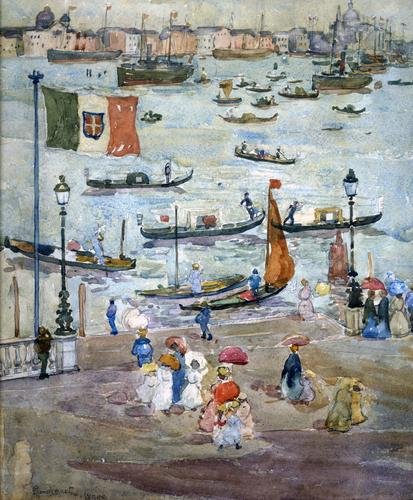
Maurice Prendergast: Canal, Venice, ca. 1898–99; watercolor and pencil on paper, Abby & Alan D. Levy Collection, Los Angeles
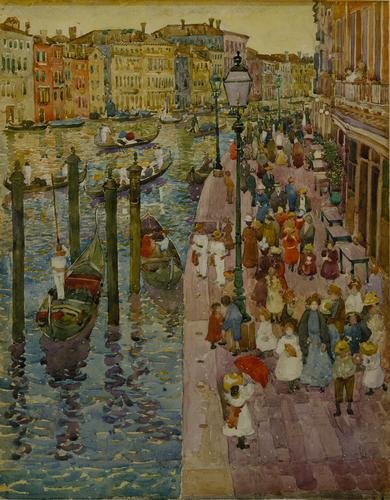
Maurice Prendergast: The Grand Canal, Venice, ca. 1898–99; watercolor and pencil on paper, Terra Foundation for American Art, Daniel J. Terra Collection, 1999
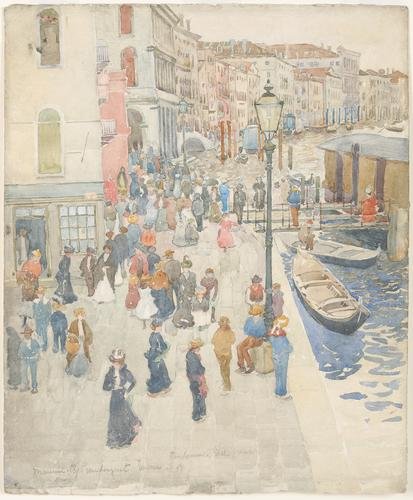
Maurice Prendergast: Venice, ca. 1898–99; watercolor and pencil on paper, Colby College Museum of Art, The Lunder Collection
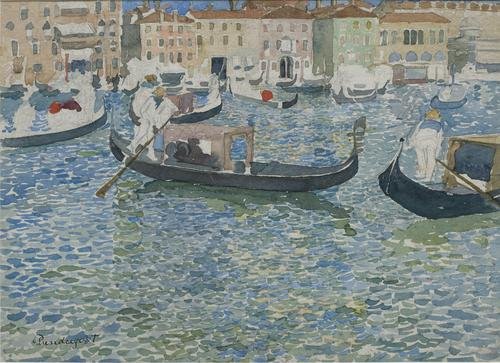
Maurice Prendergast: Grand Canal, Venice, ca. 1898–99; watercolor and pencil on paper, Williams College Museum of Art, Gift of Mrs. Charles Prendergast
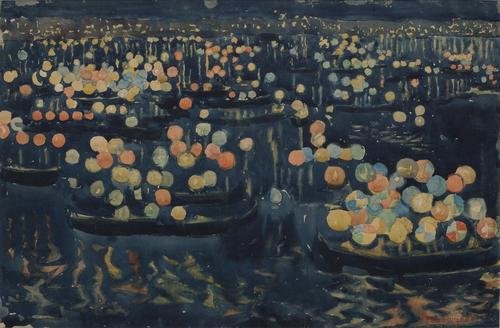
Maurice Prendergast: Festa del Redentore, ca. 1899, watercolor and pencil on paper, Williams College Museum of Art, Gift of Mrs. Charles Prendergast
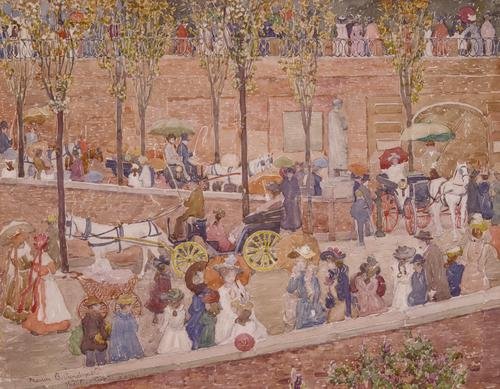
Maurice Prendergast: Monte Pincio, Rome, 1898-99, Terra Foundation for American Art, Chicago, Illinois; Daniel J. Terra Collection
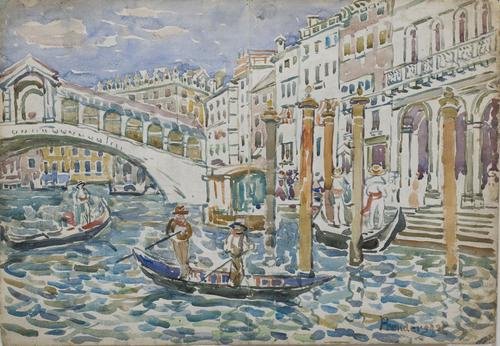
Maurice Prendergast: Ponte Rialto, Venice, 1911, Williams College Museum of Art, Gift of Mrs. Charles Prendergast
2.
September 1, 2009, 6:08 PM
The reproductions are a little dingy but the catalogue is lovely and well worth owning.
3.
September 1, 2009, 6:30 PM
Congratulations on escaping the art blog ghetto. I hope they continue to give you freelance work.
4.
September 1, 2009, 6:50 PM
Repros of Prendergast's things started improving with the introduction of digital scanning. I assume that's because of his complex and infinitely nuanced color. Before scanning, I was always pleasantly surprised to see how much better the original is, after seeing a litho repro.
Scanning his career, you can see Prendergast moving from a more or less conventional impressionism, bringing in the Japanese (diagonals, flattening of planes), toward the idiosyncratic style of the later things. He caught hell from the critics for that, but he stayed with it, getting the attention of some of his peers for his tenacity.
For me the curious thing is that, no matter how flatout at times riotously decorative his paintings are, they never lose the dignity and sense of inevitability that good painting has.
5.
September 1, 2009, 7:33 PM
I am frequently struck, when looking at Japanese prints, by how well everything hangs together despite a profusion of colors and complexity of patterns. It can be done successfully, and for Japanese print artists such skill was seemingly intuitive, even though they weren't considered "fine" artists in their own culture. No doubt some of it is simply first-rate graphic design skill fostered by a certain tradition and a certain milieu, but not infrequently the work is just too good, too inspired to be mere technique. However, I'm quite sure that tradition or standards played a very significant role in the excellence of so much Japanese graphic art.
6.
September 1, 2009, 8:14 PM
Jack, I think there's something to the idea of living tradition and standards conditioning even 'average' artists to be able to make convincing work. I think, for instance, that Abstract Expressionism produced so much convincing work because it was/is conditioned by the European painting tradition, which was on its way to becoming moribund. The AEs, it could be said, had the last waltz.
7.
September 1, 2009, 9:03 PM
"Last waltz" nothin', Tim. Despite its nearness in time, there's plenty of painting since AE that stands respectably close to the best of impressionism or cubism or expressionism or whathaveyou-ism.
Although I'll offer all my moral support to your writing endeavours I have to admit I'm not much of a subscriber, Franklin, even to those things I feel most loyal to.
Anyhow, I like these Prendergast reproductions just fine. (Only I'd like to know the sizes of the originals.) They assure me that I'll love Venice's Grand Canal along with all the rest of Italy, if I ever get to see it. I like the first one posted here best, but wish that the flag in it wasn't quite so overbearing - I wish all nationalism wasn't quite so overbearing.
The second and third Grand Canals use a surprising inversion of water and ground to achieve essentially the same composition. The fourth Grand Canal is an interestingly upside down composition: very like some Hiroshige Ando prints I've recently been exposed to. The Ponte Rialto sure is economical, if not downright sparse - maybe a little like David Milne, the Canadian.
8.
September 1, 2009, 9:13 PM
Ahab, I wish I could accept 'close' as readily as you seem to. It would make life easier.
Many in the first Impressionist circle were thorough nationalists.
Be sure to go to Venice in the off season. Tourists.
9.
September 2, 2009, 7:28 AM
Good painting, for sure, with much to recommend it, but I have never been much of a Prendergast fan. The paintings seem rather stolid and pat, the color rich enough but uninspired, kind of Bonnard Lite.
I think it is great that you have this assignment. Long overdue, given your abilities, and in one of the few venues that encourages common sense and good writing. If you and Karen end up writing for them they will have something of a monopoly in that regard.
As for subscribing, last time I subscribed it was $48, which is a little steep for someone who doesn't read that much.
Tim, the environment of the artist is a crucial determinant. This simple fact may be the single least recognized element in all creative activity because the human ego overestimates individual accomplishment and underestimates circumstances. My favorite example is the few years of Fauvism, where a confluence of factors enabled a number of marginal talents to paint great pictures for a short time. Someone could write a book about this.
On the other hand, I'm with Ahab on the what's good question. It is all too easy rest in the secure feeling that "movements" (that word always makes me think of one of my grandmother's favorite euphemisms) as the exclusive embodiment of the best, but there has been plenty of great painting in the last 50 years. It has not gotten its due.
One's taste can only be guided by one work at a time.
10.
September 2, 2009, 8:43 AM
I'm not much of a subscriber, Franklin, even to those things I feel most loyal to.
I respect that.
As for environments, it will be interesting to see if the geographically far-flung digital communities will serve.
11.
September 2, 2009, 8:52 AM
Opie and Ahab, on reflection, I concede your points, except I wouldn't agree that there is plenty of good art of any kind just now. I hope my work passes our muster.
I'm too much of an independent little cuss to join any movement, but a favorable climate would be welcome. We seem to be between favorable climates, which makes the production of any good art ( rare, you must admit) even better.
12.
September 2, 2009, 9:11 AM
I wonder if these look Japanese because of a direct influence or through Van Gogh. Seeing the progression of images here I'd have to say it looks like Prendergast began looking at more and more Van Gogh as he went on. That Ponte Rialto is very Vincent.
13.
September 2, 2009, 9:30 AM
Like opie, I've never been a huge Prendergast fan, though I like a couple of the above (especially the first one and Festa del Redentore) as much or more as anything I've seen by him. That said, I very much look forward to reading the review, and congratulations. I doubt I'll get out to Williamstown any time soon, but I may have to look into the catalog at your recommendation.
14.
September 2, 2009, 9:56 AM
Franklin, I need for environment to be actual, not virtual. But that's just me. Or is the limitation of 'virtual' the Achilles' heal of the digital realm? It's so easy (which means unreal) and initially fun (like drugs), it'll have a place in some form or other going forward.
15.
September 2, 2009, 10:52 AM
But I can't see virtual community as an environmental incubator for art because it can't vie with the actual.
16.
September 2, 2009, 11:40 AM
Tim there is a difference between "joining a movement", which is like joining a club or a political party, and what happened with AE. An artist like De Kooning would be horrified at the thought of being part of a movement, even ss he was just that. He thought even naming what was going on would be a death knell.
As it happened we can fairly accurately call those artists a movement now, after the fct, despite the disparity of styles & methods, because of the many temporal and other similarites.
When one is lucky enough to find oneself in the middle of an intense, focused creative environment where the best art is being produced it is an obligation and a privilege to run with it. Resistance is just self destructive.
17.
September 2, 2009, 12:20 PM
Opie yes we see the AEs as a group because as independent as the individuals thought themselves, they operated in a more or less common mileu, so they were answering related questions (for lack of a better way to put it), which resulted in work that can loosely be placed under the same umbrella. Is that sort of like the mileu of the Fauves? I never thought of them like that because their work is more clearly related than that of the AEs. Anyway, a more or less common mileu appeals to me more than a movement, which suggests mass thinking, like the late 60s, very unappealing.
18.
September 2, 2009, 5:36 PM
When one is lucky enough to find oneself in the middle of an intense, focused creative environment where the best art is being produced it is an obligation and a privilege to run with it.
When is the last time such an environment existed?
Rosenberg pointed out that not using a label can result in missing something important about certain groups. Ironically, the one he proposed for AbEx - Action Painting - contributed nothing but he was right in principle. In another more obscure essay he talked about "coonskinism", which I do find useful for getting a good take on AbEx art.
The art artists do is much more a product of their environment than most care to admit. It almost seems a mistake to say that artists are the masters of their art. Individual talent and discipline are necessary conditions for great art, but hardly seem sufficient. From the time of the cave painters, you had to be painting in the right cave to make it to the level of "greatness". The more things have changed, the more that has remained the same.
19.
September 2, 2009, 7:11 PM
John, exactly. But wasn't Rosenburg was being a pragmatist with the label thing?
Artists are servants, not masters. The notion of control is vanity.
20.
September 2, 2009, 7:22 PM
The idea of painting in the right cave tickles me. I'd change the name of my blog to Painting in the Right Cave if I hadn't already built such a large and devoted following under the old name.
21.
September 2, 2009, 10:10 PM
Tim: I am not ever sure what Rosenberg was up to. Here is the whole passage, from the opening of his Action Painter essay:
What makes any definition of a movement in art dubious is that it never fits the deepest artists in the movement - certainly not as well as, if successful, it does the others. Yet without the definition something essential in those best is bound to be missed. The attempt to define is like a game in which you cannot possibly reach the goal from the starting point but can only close in on it by picking up each time from where the last play landed.
For a real blast, read PARABLE OF AMERICAN PAINTING. It is much better than Action Painters.
Chris: Those who painted in the Right Cave kicked the butts of those who painted in the wrong ones, that's for sure. They did it without even knowing what was going on in the other caves. I suppose that might be a lesson for anyone who spends a lot of effort breaking wind over the bad art of today.
1.
Jack
September 1, 2009, 5:55 PM
I expect there are some reproduction issues here, which would be hardly surprising, but I'd love to see these live. Prendergast was made for watercolors, and evidently had the good sense to stick with what suited him best (unlike a good many artists, who confuse broadening their repertoire with getting in over their heads). He was also, obviously, a natural colorist, as opposed to a forced one, which never works very well. There's something vaguely Japanese here, but I suppose that was very much in the air at the time. Anyway, lovely stuff.